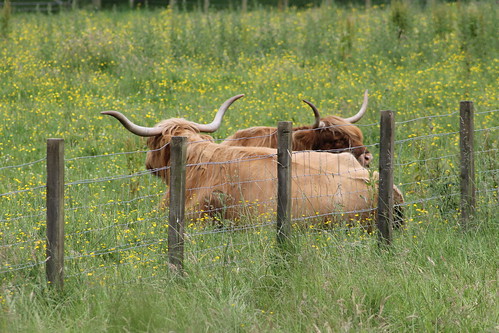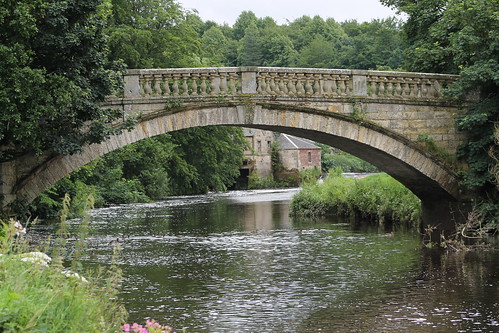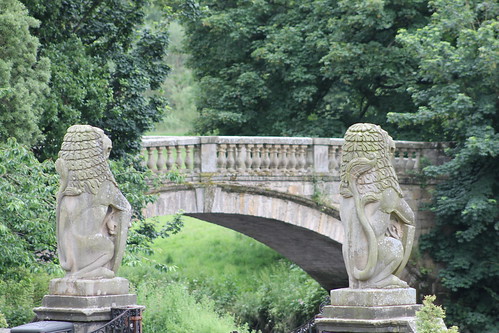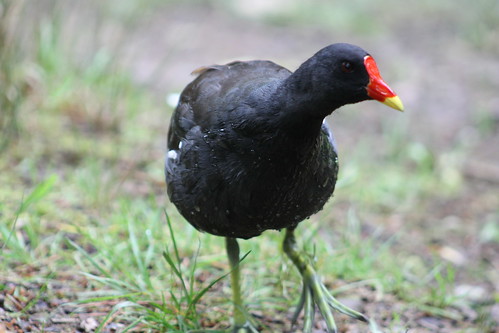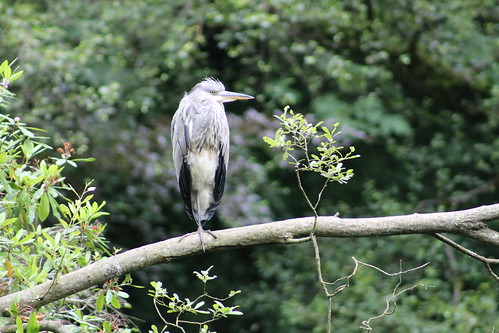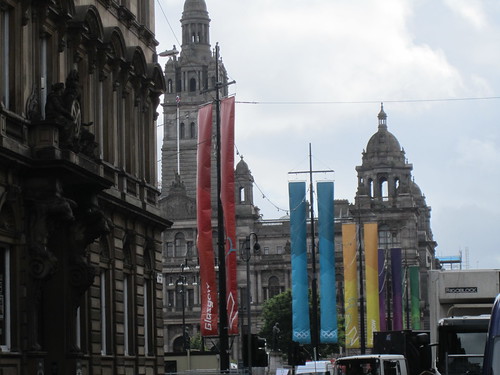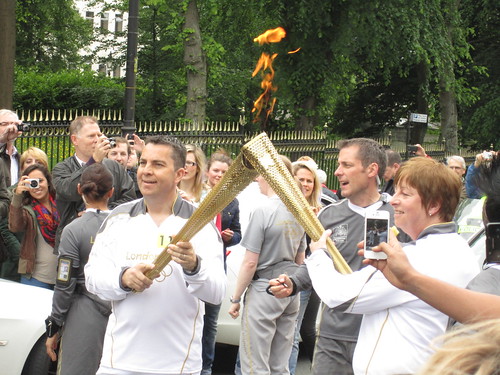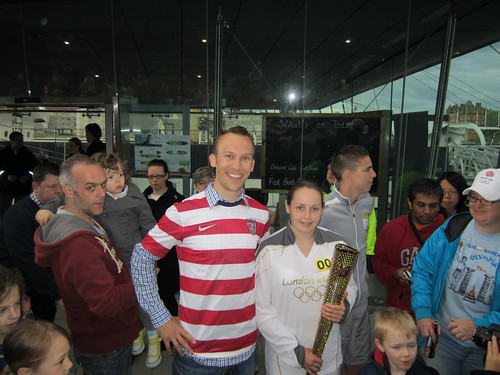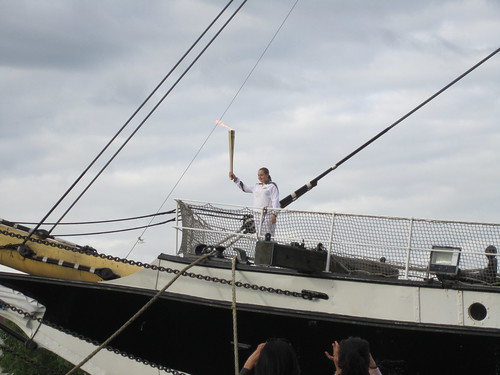Beinn Eunaich & Beinn a'Chochuill
20 June 2014
This was was actually one I did myself. Hazel left for Greenland for a few weeks, so I was on my own and really itching to get out into the hills. The problem without a car is that you're reliant on the bus and train. Luckily for me, the train from Glasgow to Oban stops at the beautiful Loch Awe at the foot of four massive munros. I wanted to do all four, but having only gone hillwalking once on my own, I thought I'd at least get two in, so I started off down the road to the footpath up to Beinn Eunaich, which looked easy since it's a farm road heading into a water reservoir stored within the mountains, but it was steep and I was not prepared! I was doing the loop backward and started up the side of Beinn Eunaich which is this relentless grassy hill that ever so slowly arches its way to the summit - you know the kind where you think you're almost there, but then you see the summit still looming in front of you? But the climb was a breath-taking one with incredible views down over Loch Awe and the picturesque Kilchurn Castle on its shores. Well, eventually I made it to the top of this slightly cobbly top (989 m/3,245 ft) and was met with even more views down the other side (which to the north was a vertical dropoff!) over the waters of Loch Etive.
 |
| Great day for a hillwalk above Loch Awe. Looking north on the way up Beinn Eunaich |
(More to read below the slideshow!)
Stob Dearg & Stob na Broige
25 August 2014
Hazel finally returned from Greenland which made getting out to further-flung munros much easier with her car, and though the Matiz is a wee one, it got us where we needed to go. The weather was perfect for late August and we couldn't believe our luck and decided to head up north to the famous Glen Coe - probably Scotland's most recognisable valley (and home to James Bond's Skyfall, in the movie at least). I'd still never been and was pumped to go!
It took a few hours to get there, and another while carefully off-roading Hazel's car into the packed parking lot (did I mention Glen Coe is popular?). We started off to the trail heading up the ridge at the eastern end of Glen Coe - Buachaille Etive Mor. The walk up was brilliant! Right through a very rocky but gently sloping Coire na Tulaich. Having not been hillwalking for a few months, we were a bit nervous about whether we'd be in shape to do it, but the walk to the ridgeline was over before we knew it! We still had another few hundred meters to get to the summit, but we were there, enjoying the absolutely perfect views of the mountains of Glen Coe and over to Ben Nevis, Britain's highest elevation, looming a few ranges away.
 |
| Beautiful peaks of Buachaille Etive Mor, guarding the entrance to Glen Coe. Who says that middle peak isn't a munro? C'mon! |
Back down the ridge we went, off to find the next munro, but there was a massive mountain between us and where the map said the next munro was. We were very disheartened to learn that not all mountains in Scotland over 3,000 ft are classified as munros as we trudged up the trail to the summit of Stob na Doire (1,011 m/3,317 ft) - which is boringly classified as a "munro top." Apparently, there is no exact definition of a munro other than that it must be over 3,000 ft (which Stob na Doire clearly meets), but a munro must also be its own mountain, standing prominently from any neighboring ridge or mountain. Stob na Doire was massive, but clearly not "a mountain in its own right" to be classified as a munro. We took a photo at the top anyway, in case the rules change in the near future and it earns classification as a Munro.
After Stob na Doire, it was almost a joke to reach the "summit" of Stob na Broige (956 m/3,136 ft) - almost 200 feet below the summit of Stob na Doire! But it still felt good to reach its top and look out over the road to Loch Etive. The weather couldn't have been better and after a quick bite to eat we started off down the mountains back to the car through a green valley lit up by the golden setting sun. It was a bit tricky getting the car out of the dirt parking lot as the ground was eroded where the pavement from the road ended, but we got her out and started the long drive back to Glasgow.
(More to read below this slideshow, too!)
Binnein Mor & na Gruagaichean
27 August 2014
We just couldn't get enough of the good weather and thought that while it lasted we should get out once more. The weather report called for clear skies, light wind, and no rain, so once again Hazel and I hopped in her "gran-mobile" and drove back up to Glen Coe. We wanted to do the Aonach Eagach ridge on the north side of Glen Coe, but after looking reports of its treachery, we decided against it until we had someone with us who could urge us along Britain's sharpest ridge walk. We decided to try some other ridge walks first before tackling that monster! So we drove through Glen Coe and then tucked east to Kinlochleven where we parked the car and headed off up to the Mamores peaks.
I'm not sure we realised just how long of a walk this was going to be. The first few miles are just a constant slight increase up a long valley (though with nice views over Loch Leven and the town below), until the path dumps you out into a beautiful valley perched up between Binnein Mor (our first destination) and the neighbouring munro Sgurr Eilde Mor. While the day was just as sunny as the previous walk, the air was not nearly as still and we were being buffeted by very stiff and strong gusts of wind! We worked our way up to the ridge overlooking Coire an Lochain where we had spectacular views of Ben Nevis across the valley, and even though our legs were about to give out, we still weren't at the top! Out of 282 munros, Binein Mor is the 28th highest and we still had to get there. We met some nice Dutch tourists and caught up with a single hillwalker who was bagging his 200-and-something munro. He reassured us that Aonach Eagach's bark was worse than its bite, but that with the stiff winds, it was better we weren't on that ridge. We made it to the summit of Binnein Mor (1,130 m/3,707 ft) which is perched on a little point in the sky with very steep and long drop-offs on either side! Vertigo definitely set in a few times, especially with the wind, but once we sat for some water, we got over it pretty quickly.
 |
| Chilling out on top of Binnein Mor. Munro #10! |
(There's one more section to read below this slideshow!)
Ben Lui & Beinn a'Chleibh
14 September 2014
The weather's been changing a lot around Scotland as Fall starts to set in but the weather report suggested we'd have clear skies and cloud-free munros over the weekend, so my intrepid munro-bagging-partner, Hazel, and I went for it. We drove west to Ben Lui, which was described as one of the finest munros in scotland with amazing views, but we had the feeling, as we parked the car, that those views would not be for us today. Clouds were low and the peaks of all the munros were shrouded in mist. But we were here so might as well go for it anyway!
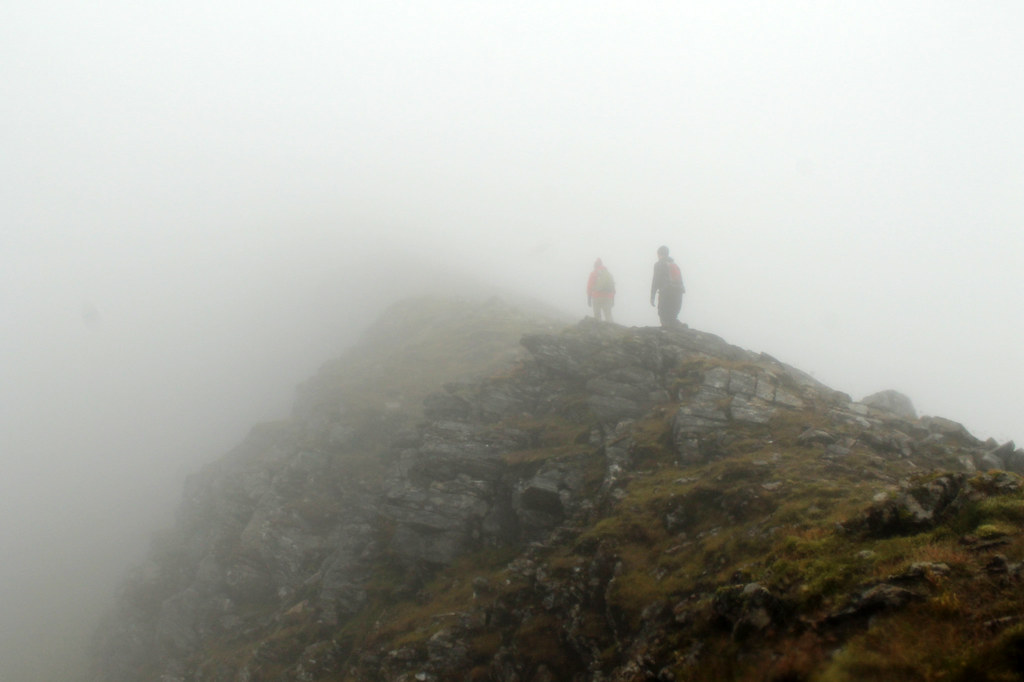 |
| Carefully keeping to the path in the fog along the ridge to Ben Lui |
After a few fun scrambles and photoshoots, we made it to an open plateau with a cairn that we thought was the summit, only to realise we had a little further to go before reaching Ben Lui's true summit (1,130 m/3,707 - the same height as Binnein Mor, but ranked 29th). It was too cold and damp to linger there much longer so we headed down to the bealach and it was pretty much a hop, skip, and a jump up to the summit of the neighbouring munro, Beinn a'Chleibh (916 m/3,005 ft) which was cloud-free for a while. But there was no reason for it not to be cloud free - after all, Beinn a'Chleibh is the 281st highest munro out of 282! So, not spectacular, but fun to check it off the list nonetheless. Clouds eventually did roll in and we never really got a good clear view of Ben Lui all day. We ran into many people who were doing one or two more munros after Ben Lui and Beinn a'Chleibh, but I'd injured my knee running the day before so we decided to head back to the car, which didn't take long, and it was nice not having a three-hour drive back home. Not sure how many more nice days we'll have, but so far, nothing can stop us!


